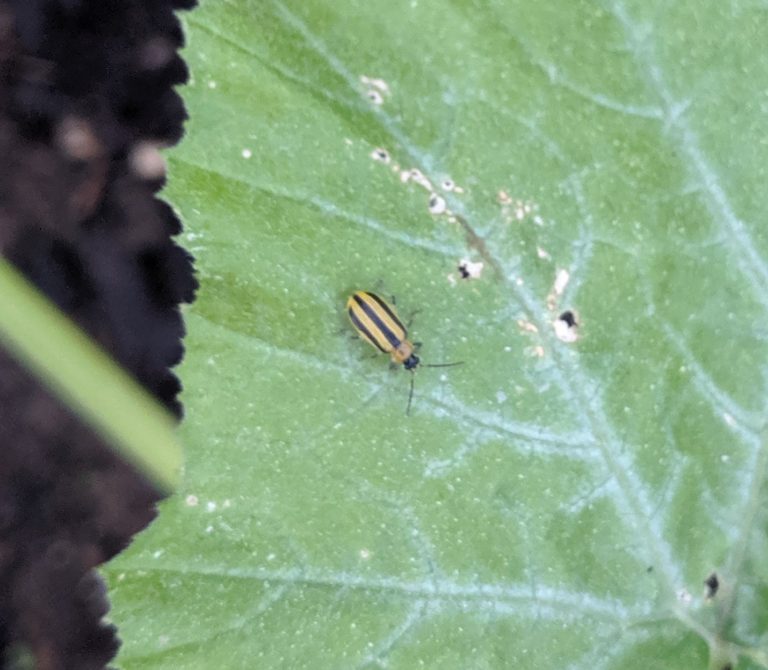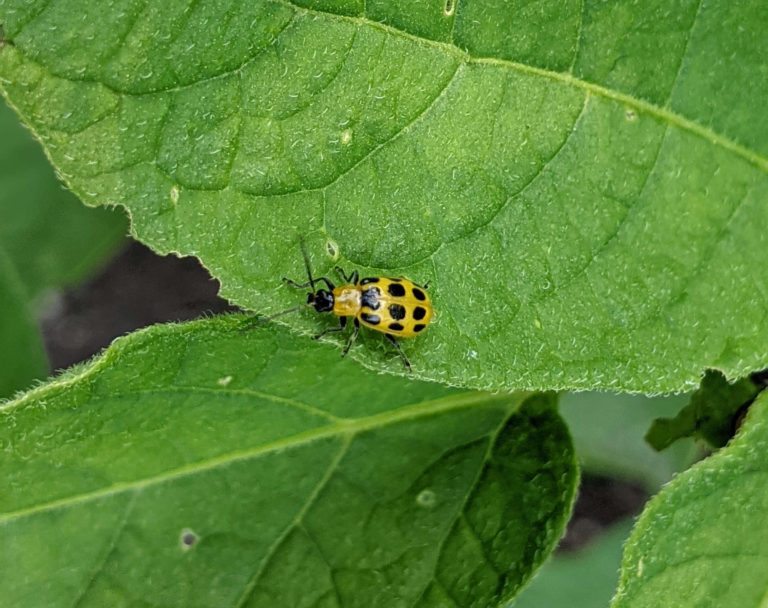Cucumber Beetle
Insect Identification
Images
Damage
The Beetle larvae and adults consume the roots and above-ground growth of the plant, respectively. While the root consumption of the larvae does not affect plant health, the damage done by the adult is more substantial. This damage manifests itself in two ways. The first is through consumption of leaves which leaves them looking lacy in appearance. The second is that the beetle is a carrier of bacterial wilt.
Bacterial wilt is a disease that infects the plant and causes its leaves to wilt. In the early stages, this wilting closely mimics a plant in need of water. It progresses rapidly and results in the death of the plant in about a week from the first signs. To verify your plant is infected, cut the stem in half, press the cut ends back together for 10 seconds and slowly pull them apart. If you see an ooze-line string between them, the plant is infected and must immediately be removed from the garden and thrown in the garbage. There is no chance of saving it. Do not compost the diseased plant in the garden compost pile.
Affected Plants
- Corn blossoms
- Cucurbit family
- Summer squash
- Melons
- Pumpkins
- Cucumbers
- Sweet potatoes
Management
Control techniques are listed in order of effectiveness.
Row covers
- For cucurbits grown on the ground, floating row cover is a great way to prevent a wide variety of pest from being able to access your plant. If you trellis your plants, cover your plants for the first 2-3 weeks after transplanting before working them into the trellis. If possible, continue to cover the plants with row cover until they begin to flower.
Insecticides
- If you have had issues with bacterial wilt in the past, physical barriers such as row covers mixed with a preventative insecticide such as neem may offer a satisfactory level of protection. For plants that are more resistant to bacterial wilt (and if you have not experienced bacterial wilt in your plot), a reactionary strategy is a better approach. Wait until you see defoliation in the neighborhood of 20% before you apply insecticides.
- Neem
- Note: Neem only prevents feeding on leaves that have been sprayed. Growing plants with new leaves will not be protected and will be susceptible to damage. Monitor new growth carefully and spray again (follow instructions on the insecticide carefully) if damage on the new leaves is identified.
- Note: Neem only prevents feeding on leaves that have been sprayed. Growing plants with new leaves will not be protected and will be susceptible to damage. Monitor new growth carefully and spray again (follow instructions on the insecticide carefully) if damage on the new leaves is identified.
- Insecticidal soap
- Neem
Mulch and weed
- It is important to keep your garden clean and free from weeds as some plants serve as a host for adults.
- After transplanting, mulch the plants heavily. This both discourages egg laying and provides cover for wolf spiders that feed on cucumber beetles.
Physical removal
- The cucumber beetle is a very difficult insect to catch due to its ability to fall off the plant the moment they detect a disturbance.
- Place a thin sheet of plastic around the base of the plant. Gently shake and brush the leaves of the plant to encourage the beetles to fall into the sheet. Pick them from the sheet and squish them with a gloved hand.


